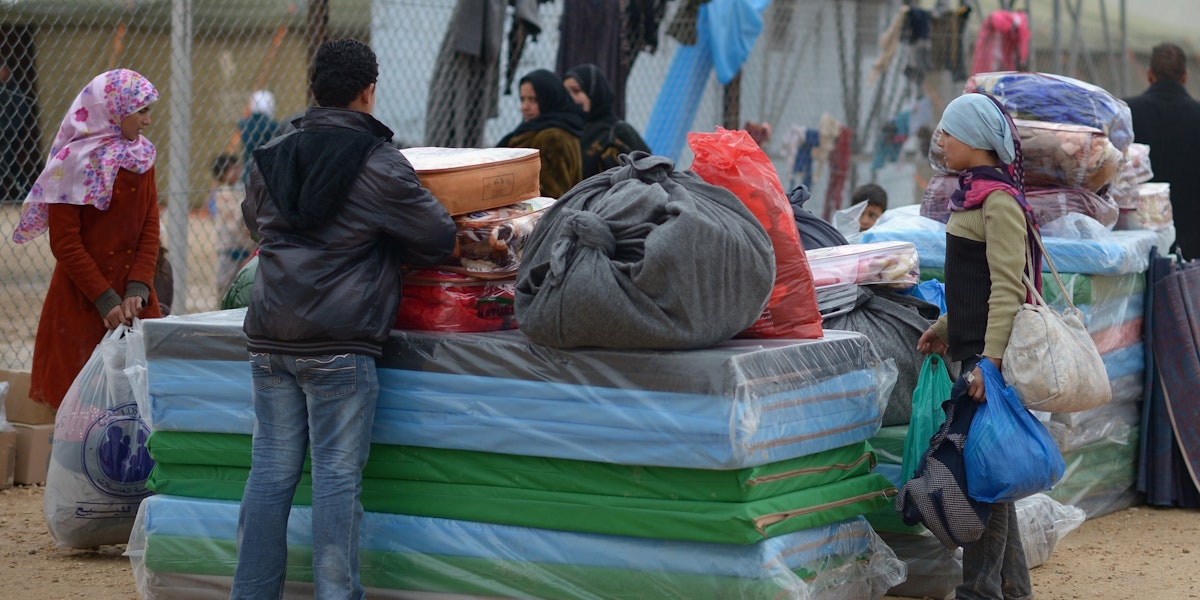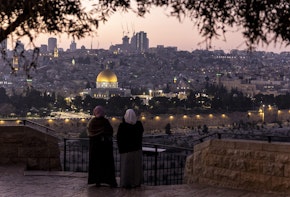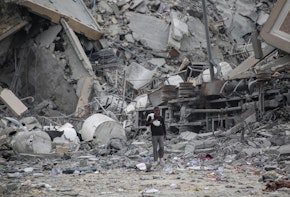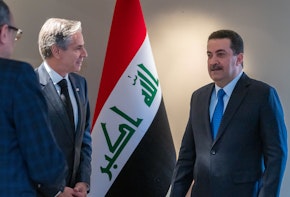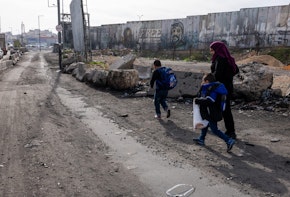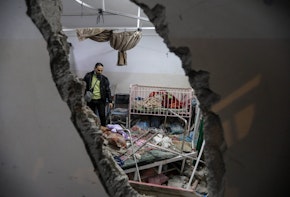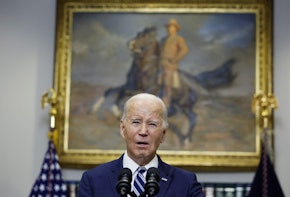In the past forty years, the United States has resettled1 over three million refugees,2 offering victims of persecution and conflict the opportunity to build a new life. In Fiscal Year (FY) 2016,3 the United States will admit up to 85,000 refugees through the United States Refugee Admissions Program (USRAP); the administration plans to admit 100,000 refugees in FY2017.4 The largest number to arrive—34,000—will be resettled from locations in the Near East and South Asia.5 This regional quota will include “at least” 10,000 Syrian arrivals, under plans announced by President Barack Obama in September 2015.6
However, in the wake of the Paris terrorist attacks, there have been widespread calls for the United States to suspend Syrian refugee resettlement.7 Further calls to restrict immigration from Muslim regions have been made in the wake of the San Bernardino shootings in California on December 2.8
The recent controversy over Syrian resettlement has raised important questions about USRAP. Is refugee resettlement safe? Is it effective? Is resettlement just one form of humanitarian relief, or can it also advance U.S. strategic interests? Should the number of refugees being resettled to the United States be increased? Does USRAP have the capacity to expand its operations? And what additional resources—either pre- or post-arrival—could help to ensure the success of such an expansion?
Refugee resettlement is unequivocally safe. It would be wrong, both morally and politically, to curtail Syrian refugee resettlement, and why it is in fact both ethically imperative and politically expedient to instead expand U.S. commitment to refugee resettlement. Resettlement could help both to meet humanitarian needs in the region and advance the U.S. strategic interests, above all by providing another means of leverage through which to broker regional and EU engagement with Syrian crisis. The United States is already the single-largest donor of humanitarian relief to the Syrian people—having given some $4.5 billion in aid since the beginning of the conflict9—but it is increasingly clear that offering more resettlement places is essential to help alleviate the political strain of hosting millions of refugees in the region, and to meet some of the refugees’ urgent needs.
The United States can—and should—continue to protect itself against terrorist threats, but it can do so while still admitting a greater number of Syrian refugees for resettlement, and processing applications more quickly than it does now. In resettling more Syrian refugees quickly and equitably, Washington will win a moral victory, which in turn will help it persuade allies to do more to help resolve the Syrian war and the attendant humanitarian catastrophe. Instead of seeking to dismantle refugee resettlement, those interested in ensuring the program is both safe and effective should focus their efforts on securing the resources needed both to reduce delays in processing and to establish strong foundations for community integration upon arrival.
This policy brief—divided into six sections—explores the Syrian resettlement issue and provides a roadmap for safely meeting and even expanding America’s commitments to resettle refugees. Part one sets out the new challenges facing USRAP in the aftermath of the Paris attacks. Part two outlines the differences between European and American exposures to Syrian asylum seekers. The third part considers the history of U.S. refugee resettlement, and the next a profile of USRAP today. The penultimate part of the paper then considers USRAP’s role in Syria, and the sixth and final section offers some conclusions and recommendations for policymakers.
Resettlement after Paris: New Fears
On November 13, 2015, a series of coordinated terror attacks across Paris, France left 130 dead and 268 injured. On November 14, Islamic State (ISIS) claimed responsibility for the attacks.10
All those directly involved in perpetrating the attack are believed to have been EU citizens.11 However, the discovery of two Syrian passports at the attack sites created fear that the terrorists were Syrian nationals. What is now known is that, after traveling to Syria, at least two ISIS operatives reentered the EU as “refugees” in October 2015, arriving on the Greek island of Leros with other Syrian asylum seekers. It is believed that these terrorists used stolen Syrian passports to take advantage of the chaotic and over-burdened Greek asylum system and avoid detection by EU security forces on their reentry.12 The discovery of these Syrian passports at the attack sites suggests that ISIS is deliberately planting such evidence, attempting to fuel xenophobia, anti-Islamic and anti-refugee sentiment in the West.13
In the United States, the tactic of linking Syrian refugees to fears of terrorism has had a measure of success for those politicians seeking to tap into the xenophobic tendencies of their base. Following the Paris attacks, repeated calls were made for the United States to suspend all resettlement of Syrian refugees. Governors from thirty-one states publicly declared they would not accept Syrian refugees under the current resettlement program, due to security fears. Every Republican governor except Gary Herbert of Utah affirmed their opposition to Syrian resettlement. Only one Democratic governor—Maggie Hassan, of New Hampshire—joined them. It is important to note that, despite the political storm, state governors have no power to actually refuse Syrian refugees entry.14 Yet their campaign created considerable political pressure for the federal government and fanned a populist wave of anti-immigrant sentiment. Other commentators—including Republican presidential candidates Donald Trump, Jeb Bush, and Ted Cruz—suggested that the United States should halt the program, or admit only Christian Syrians.15
On November 17, the the American Security Against Foreign Enemies (SAFE) Act was introduced in the House of Representatives. This bill would impose additional security measures on the refugee resettlement program, namely requiring the director of the Federal Bureau of Investigation (FBI) to certify to the secretary of homeland security and the director of national intelligence that any Syrian or Iraqi applying for entry as a refugee poses no security threat to the United States.16 On November 19, the American SAFE Act was passed by a vote of 289 to 137—sufficient to override a promised White House veto, should the bill pass through the Senate (where Minority Leader Harry Reid has vowed to block it).17
The White House has strongly resisted calls to curtail or suspend the U.S. refugee resettlement program in the wake of the Paris attacks, or to reconsider current plans to admit 10,000 Syrian refugees in 2016. President Obama has instead argued that there are compelling reasons—both moral and political—why the United States should continue to resettle refugees, insisting that “slamming the door in their faces would be a betrayal of our values. . . . That’s not American. That’s not who we are. We don’t have religious tests to our compassion.”18
Refugees not Asylees: Orderly Arrival
America’s refugee resettlement process has nothing in common with the massive spontaneous human wave of displaced people that has swept into Europe this year by boat and in long, marching columns. The orderly arrival of refugees to America under the aegis of USRAP is orders of magnitude smaller, and completely government-controlled. The European crisis, which wrongly informs much of the public discourse in the United States about refugees, has seen an estimated 989,215 migrants (including hundreds of thousands of refugees) arrive, the vast majority smuggled across the Mediterranean sea to arrive in Greece or Italy. The EU is obligated under international law to admit all those who arrive claiming asylum, and to hear their claim.19
The European asylum crisis is indeed a challenge for receiving countries. Upon arrival, many of these asylum seekers are in need of urgent humanitarian assistance. Many asylum seekers also seek to evade formal registration in European entry points such as Greece and Italy because they wish to continue their journey rather than face processing in southern Europe (refugee recognition rates are lower in Mediterranean states than in Sweden or Germany, for example, and economic prospects are limited).20 Disputes between EU member states and the decision by some states (such as Hungary) to adopt restrictionist policies have contributed to a failure of coordinated action, political paralysis, and border chaos that may have allowed some extremists to travel through Europe in the midst of the refugee crowd.
U.S. refugee resettlement is an entirely different process. It is safe, because it is a tightly controlled, carefully managed program, admitting a pre-determined number of recognised refugees, dispersed across forty-nine states and territories.21 There are no yet-uncounted masses arriving in fleets of small boats or marching columns. Instead, refugee arrivals are planned by U.S. authorities, and spread throughout the year. In October 2015, just 5,348 refugees were resettled across the United States—including 187 Syrians. The figures for November 2015 were 3,692 and 250, respectively.22 Only 1,682 Syrians arrived in the United States during the whole of FY2015.23
U.S. law explicitly distinguishes between refugees—those who arrive through USRAP, having been granted their status outside the United States—and asylees, who make a claim for protection once they are already in the United States or on their arrival at a port of entry.
There are Syrians seeking asylum in the United States, but the numbers are relatively small. In FY2014, the United States received 41,920 asylum cases in total, from all nations, but it processed about half that number, granting asylum in only 49 percent of cases. From that total number, just 1,586 Syrians applied for asylum in the United States. The numbers for FY2015 are tracking even lower, with only 636 Syrians having applied in the first half of the year. Asylum recognition rates for Syrians currently run above 80 percent.24 While there is a growing asylum case backlog—and this should be a concern for all those interested in ensuring the United States asylum process is fair and timely—there is also no evidence that asylees pose a security threat, nor that the U.S. asylum system is in danger of being overwhelmed.25
A History of Resettlement
Under international law, the United States has a legal obligation to adjudicate asylum cases.26 However the obligation to resettle refugees through USRAP is self-imposed. So why has the United States chosen to resettle three million refugees since 1975?
U.S. commitment to refugee resettlement has always combined humanitarian relief with strategic interest. The earliest U.S. resettlement programs were established post-World War II. Although the distinction between immigration and refugee admissions was not always fully articulated, a series of laws—including the 1948 Displaced Persons Act, the 1953 Refugee Relief Act, and the 1957 Refugee-Escapee Act—provided for the arrival of hundreds of thousands of refugees from war-ravaged Europe, with a particular focus on those excluded under the national origins system and escapees from Communist-dominated countries.27
Parallels can be seen between current fears and concerns in the 1950s about the need to carefully screen refugees arriving from Communist countries. In 1954—at the height of McCarthyism—the official appointed to oversee administration of the Refugee Relief Act, Edward Corsi, was dismissed due to alleged connections with the American Committee for the Protection of the Foreign Born, which was suspected of being a Communist front organization. During Senate subcommittee hearings, Corsi in turn countered that an obsessive “psychology of security” at the State Department meant that refugees were being “investigated to death.”28
Supporters of the resettlement programs—including President Dwight Eisenhower—underlined that such refugee resettlement was not just a humanitarian act, nor just the demonstration of a commitment to American values and “traditional solidarity with the oppressed.” It was also an important means of demonstrating solidarity with Western Europe, and a means of defusing an “economic and political threat of constantly growing magnitude” by ensuring that the displaced were not left in camps for years, at risk of becoming radicalised.29 These three considerations—a humanitarian and moral imperative to help the distressed and demonstrate the strength of liberal values, a show of solidarity with over-burdened allies in Europe, and the need to prevent marginalization leading to extremism—remain relevant today.
In 1975, an Indochinese Refugee Resettlement program was established in recognition of the fact that U.S. evacuation from the region had left many—especially those who had assisted with military operations in Vietnam and Cambodia—at risk. The Indochina Migration and Refugee Assistance Act marked a new commitment to mass resettlement: in the five years leading up to 1980, 130,000 Indochinese refugees were resettled in the United States through the program. Perhaps most important was the establishment of a federal program offering post-arrival assistance, despite widespread opposition to incurring such high costs ($1 billion a year) in a time of high American unemployment.30 The program also reflected a special interest in helping to resettle refugees from areas where U.S. military engagement may have contributed to displacement, or exposed certain groups—for instance translators assisting U.S. operations—at special risk of persecution. This continues to be an important consideration, as demonstrated by current Special Immigration Visa (SIV) programs for Iraqi nationals.31
The Indochinese Resettlement Program laid the foundations for a later uniform and global refugee resettlement program, USRAP, which was established through the 1980 Refugee Act. The U.S. Refugee Act established a nominal ceiling of 50,000 for annual refugee admissions, to be adjusted on a yearly basis: in 1980, the refugee ceiling was set at 231,700. This remains the highest annual quota set to date: the refugee ceiling fell to 72,000 by 1984, before rising again to 142,000 in 1993 (in part as a response to conflict in the former Yugoslavia). Since 2002, the quota has remained stable, between 70,000 and 80,000 a year (until President Obama announced new plans to raise the quota to 85,000 for FY2016 and 100,000 in FY2017).32
With the end of the Cold War, “easy” caseloads from the former Soviet Union and Southeast Asia declined in number. Concerns were also raised about fraud and corruption among African groups petitioning for family reunification, resulting in a significant decrease in admissions under this program. Most seriously, in the immediate aftermath of the 9/11 attacks, refugee admissions to the United States were halted for two months, pending a root and branch security review of the admissions process. When the program resumed, stringent additional security checks resulted in a sharp decline in arrivals, with only 26,788 refugees admitted in FY2002.33
At the time, many commentators expressed concern that these challenges would permanently diminish U.S. commitment to large-scale refugee resettlement. However, new security checks, combined with greater levels of interagency cooperation, helped to unblock the resettlement pipeline, and new groups of persecuted refugees—including Somali Bantu and Bhutanese Nepalis—were identified for admission. In 2014, the full 70,000 quota was used to resettle 69,987 refugees.34
The history of U.S. refugee resettlement thus offers a reminder that the current tension between humanitarian action and security fears is not new. Refugees have often arrived from regions where groups are actively hostile to American interests and values. This is because it is often refugees from these places—whether Hungary in the 1950s, Vietnam in the 1970s, Somalia in the 1990s, or Iraq and Syria today—who are most in need of resettlement, and where U.S. foreign policy interests can best be served through such action.
History also offers important lessons about how to respond to such security fears. First, it is important to recognise that the refugee resettlement ceiling sets an upper limit for admissions. It is easy to stop the admission of refugees, if circumstances warrant. As events in 2001 demonstrate, when concerns were raised about the security and integrity of the refugee resettlement process, USRAP was able to immediately halt the program and impose new security measures. American security was prioritized over the movement of (often acutely vulnerable) refugees. Second, the post-2001 USRAP is already extremely robust in terms of security processing. Since 9/11, only three refugees—from a total of 784,000 resettled in America through USRAP—have been arrested and convicted on terrorist-related charges.35 We should acknowledge that no screening program can offer a perfect guarantee against a refugee, in the future, committing a violent crime or an act of terrorism. Yet, to allow such extreme outliers to shape the future of refugee resettlement would be grossly misguided, and a victory for terrorism: ISIS has repeatedly made clear its opposition to refugees leaving the region.36
U.S. Resettlement Today
The United States remains the global refugee resettlement leader today, although resettlement needs continue to far outstrip the worldwide supply of resettlement places. The United Nations High Commissioner for Refugees (UNHCR) estimates that in 2016, globally, 1,150,000 refugees will be in need of resettlement; but by way of comparison, only a total of 73,000 refugees (6 percent of that number) were resettled in 2014.37 The United States was responsible for admitting two-thirds of that number (48,911 refugees), underlining the crucial role USRAP plays in meeting urgent global resettlement needs.38
USRAP has a multi-tiered process for resettling refugees, prioritized according to the category of their circumstances. UNHCR-referred refugees are “Priority 1” (P-1) resettlement cases in this system. While a referral to the P-1 program allows a refugee the opportunity to interview with a United States Citizenship and Immigration Service (USCIS) official, the decision to admit the refugee lies solely with USCIS. The United States also runs a number of “Priority 2” (P-2) programs, which focus on helping groups of special humanitarian concern as identified by USRAP. Current groups identified for P-2 processing include Burmese ethnic minorities in Thailand and Malaysia, Bhutanese in Nepal, Congolese in Rwanda and Tanzania, and Iranian religious minorities. A third category, “Priority 3” (P-3), admits the immediate family members of refugees of designated nationalities who had been previously resettled under USRAP. Nationals from twenty-four countries—including Syria and Iraq—are currently eligible for P-3 processing.39
Prior to Arrival: Security Screening
Security checks for refugees seeking admission under USRAP are extremely robust. Whether a P-1 file is referred via UNHCR (as in 75 percent of cases), or an individual makes a direct application under the P-2 or P-3 routes (25 percent), a case is then prepared by one of nine Resettlement Support Centers (RSC).40 The RSC gather biographic and other information prior to each refugee’s adjudication interview, to assist with security screening. Specially trained USCIS officers review this data, and then conduct an in-person interview before deciding whether to approve the resettlement application.41
An approved refugee must then undergo enhanced security screening and medical testing (with a particular focus on ensuring no individual with active tuberculosis arrives in the United States), and must also have a U.S.-based resettlement agency with experience in providing assistance upon arrival make a “sponsorship assurance.” This process is thorough and time-consuming: on average, it takes 18 to 24 months from initial referral of a refugee by UNHCR to the resettlement program before they arrive in the United States.42
A large part of that nearly two-year timeframe is consumed by extensive security checks. All refugees, of all nationalities, go through both biographic and biometric (fingerprinting) security checks. These are interagency processes that require coordination between USCIS, Department of Homeland Security (DHS), the FBI, and the Department of Defense. The result is that any refugee arriving through the resettlement program has passed through far stricter security vetting than any immigrant arriving through a student or temporary worker channel, or travelers entering through visa waiver programs.43
To address particular concerns in the Syrian context, all Syrian refugees must also undergo additional checks as part of a Syrian Enhanced Review process. Although details of this program are classified, it involves heightened levels of scrutiny including, where necessary, review by the Fraud Detection and National Security unit and additional interviews. As Department of State officials have noted, “Iraqis and Syrians tend to be a very, very heavily documented population,” especially in comparison with other refugee populations, which assists with this process. UNHCR has also been “extraordinarily cautious” in seeking to avoid referring cases to the United States (which has more stringent security checks than other resettlement countries) that might be refused or delayed on Terrorism-Related Inadmissibility Grounds (TRIG).44
These checks exclude many refugees from the resettlement program. Just over 50 percent of refugees who apply to USRAP satisfy these requirements, and are approved for resettlement.45 To be clear, this does not mean that almost half of those referred pose a security threat to the United States. Instead, the low approval rate should be read as evidence that refugees are required to meet an extremely high burden of proof before being cleared for admission. In fact, many excellent candidates for resettlement are peremptorily rejected, and careful consideration should be given to ensuring that a focus on security does not exclude refugees who could make a significant contribution to the United States through their knowledge, expertise, skills, and finances.
The high standards of the interagency security system established post-2001 mean that USRAP is extremely unlikely to be the target for extremist infiltration. However, questions have been raised about the capacity of USRAP to process referrals effectively. Many refugee advocates argue that long processing times reflect not only thorough vetting, but also delays due to resource and staffing constraints. If large numbers of Syrian refugees are to be resettled, Congress must allocate sufficient resources to ensure the program can meet humanitarian need through timely processing. Currently, delays in resettlement processing leave many refugees’ lives in limbo between initial USCIS approval and departure, waiting months and in some cases years before finally being able to begin their new lives. The slow pace of resettlement means that, in many cases, refugees must continue to live with the threat of further violence and persecution.46 It has been clear for many years that in some cases, refugees die while waiting for resettlement processing to be completed.47
Canada’s plan—fulfilling an election pledge made by the new Trudeau administration—to admit 25,000 Syrian refugees by the end of 2015 (later delayed to February 2016) is proof that resettlement processes can be dramatically sped up if sufficient resources are allocated. The mobilisation of commercial shipping, use of Canadian army bases as housing and reception centres, and Canada’s private sponsorship model could all be potentially adapted for use in a drastically scaled-up U.S. resettlement program.48
Post-Arrival: Integration Challenges
There is absolutely no evidence that radical Islamists—or any other terrorist groups—are able to infiltrate American refugee resettlement channels. Rigorous pre-arrival security checks prevent this. However pre-arrival screening is only one part of the process. In the long-term, security also depends upon refugees’ successful integration after their arrival. The links between poverty, social marginalization, and radical violence have seen second-generation immigrants prove susceptible to extremist propaganda. All of the Paris terrorists identified (to date), for example, were EU citizens, and the 2005 London Underground attacks, or 7/7 bombings, were carried out by British terrorists.
Traditionally, USRAP’s post-arrival activities have concentrated on securing refugees employment as quickly as possible, as the Department of State Reception and Placement Program only provides resettlement agencies with funding to support refugees for the first thirty days after arrival. However, this approach has been criticized for prioritizing immediate, often minimum-wage work over securing a good job match, especially for more highly educated refugees. Studies show that resettled refugees’ incomes remain below the average for native-born Americans, even twenty years after arrival.49 Only minimal attention has been paid to supporting refugees’ social and cultural integration.
The need to consider the social and linguistic aspects of refugee integration has become increasingly evident, in part because of a demographic shift in the type of refugee being resettled through USRAP. A focus on the most vulnerable groups—such as female-headed households—has undoubtedly allowed USRAP to continue to meet the refugee ceiling despite heightened security measures that have left many refugees (particularly men of combat age) ineligible for U.S. resettlement. But the result has been to increase the numbers of resettled refugees arriving with extremely poor English-language skills and limited education. Among refugees arriving from Burma, Bhutan, Liberia, and Somalia between 2004 and 2013, for example, fewer than half were literate in their primary language.50
The result of this demographic shift has been to increase refugees’ social marginalization and reduce community cohesion—which has in turn fed hostility in local resettlement communities. As a 2010 Senate report concluded, “resettlement efforts in many U.S. cities are underfunded, overstretched, and failing to meet the basic needs of the refugee populations they are currently asked to assist.”51
So while concerns over the immediate risk posed by admitting Syrians are certainly unfounded, many of those who recently have expressed anxiety do feel genuinely aggrieved by the impact of recent refugee resettlement at a local level. This is particularly true in cases where refugees require significant levels of support and are accustomed—after years or decades in refugee camps—to rely upon aid, so struggle to become self-sufficient.
Efforts are being made to broaden resettlement reception programs to address these concerns. In April 2015, the White House Task Force on New Americans submitted a number of recommendations to the president intended to strengthen the cultural, economic, and linguistic integration of new immigrants and refugees.52 In June 2015, the Strengthening Refugee Resettlement Act was introduced in the House of Representatives: this act would expand resources for community integration in the first year of refugees’ arrivals, but has failed to move beyond the committee stage.53 Increased funding for English language lessons (including prior to arrival), housing, and education needs are important means of facilitating better prospects for integration. Another potential model to explore is privately sponsored resettlement: sponsors are particularly well-placed to help with social and cultural integration at a community level.
USRAP and the Syrian Refugee Crisis
There currently are over four million Syrian refugees, making the Syrian crisis the largest in the world today. Faced with such acute humanitarian suffering, the moral imperative for accepting more Syrian refugees is obvious. One question that should be asked, however, is: Why only 10,000 additional places? Another question is: Why Syria?
It is important to consider Syria and USRAP’s role in the context of a global refugee crisis. At the end of 2014, UNHCR estimates that there were 19.5 million refugees displaced worldwide (as well as 38.2 million internally displaced people and 1.8 million asylum seekers). Although Syrians are the largest group, there are also 2.5 million Afghan, and 1.1 million Somali refugees. Many of these refugees have been waiting decades for a solution to their displacement, with little prospect of a sustainable return “home.” This is also true for refugees from other crises: Iraqis, Eritreans, Congolese, Burundians, Burmese, and more.54
One reason for focusing on Syria’s refugees is urgency. UNHCR have made repeated pleas for additional resettlement places to be offered to Syrians to help meet the unprecedented scope of this refugee crisis.55 As of November 24, 2015, 160,664 additional places had been offered by thirty states, through various resettlement and humanitarian visa schemes.56 However, this represents only a small fraction of Syria’s resettlement needs—and represents what should be considered at best an optimistic tally, at worst a misleading one. In the case of some states, these numbers are very different, and arrivals will be spread out over a number of years (for example, the United Kingdom has offered to accept 20,000 Syrians by 2020, but has only welcomed 216 Syrians through resettlement to date). UNHCR figures also include the number of resettlement submissions made to USRAP—22,427—conveniently ignoring the fact that U.S. officials only expect to approve about 50 percent of these cases, closer to the “at least 10,000” resettlement pledge. For the United States to withdraw from resettlement now would have serious repercussions in terms of global commitment to Syrian resettlement.
Helping Syrian refugees is also in the United States’ own strategic self-interest. Accepting more Syrian refugees gives the United States more credibility with its rivals; the Assad regime and its foreign backers tend to dismiss Washington as a paper tiger, so any evidence of U.S. commitment to its Syria policy helps reverse an unfortunate trend. Furthermore, Syrian resettlement is also strategically important in terms of wide U.S. engagement in the broader region, including with the Gulf monarchies and Turkey, Lebanon, and Jordan; as the United States assumes a greater share of refugee resettlement, it will have an easier time persuading U.S. allies to coordinate policies toward Syria and fall in line with U.S. preferences.
Strategic and humanitarian imperatives are mutually reinforcing. Refugee-hosting countries in the region are overwhelmed. Lebanon—a state close to breaking point—is currently hosting 1.1 million refugees—an astounding one refugee for every four residents. It is projected that Turkey will host 1.7 million Syrian refugees by the end of 2015; Jordan 680,000.57 Protection space for Syrians is extremely fragile in all these states, with refugees being afforded limited socioeconomic rights and aid budgets having been drastically reduced due to funding shortages. Stagnating refugee camps are often fertile recruitment grounds for armed groups, and this is a risk in the Syrian context.58 By showing solidarity, U.S. resettlement programs can help to check unrest in host states, offer refugees hope, and in turn the United States can demand more of its partners and allies. However, to make any significant contribution to the prospects for regional stability, resettlement needs to be carried out on a much greater scale.
If the United States assumes a more equitable share of resettlement, Washington will also gain political capital it can use with respect to international organizations and the Europeans. It will also address a very real security threat and humanitarian crisis. In the past six months, Europe’s inability to respond in a coordinated and collective fashion to the refugee and migrant crisis unfolding at its borders has underlined the need for an effective American response. The Paris terrorist attacks suggest that ISIS have already exploited the EU’s political paralysis: a large-scale, extra-regional, American-led resettlement program could meet humanitarian need, help to reduce this security threat, and—perhaps most importantly of all—demonstrate a real commitment to international protection. In recent months, many of Europe’s leaders have questioned the continued viability of a global asylum regime: U.S. action could help to protect vital safeguards for those fleeing tyranny.
There is therefore both a humanitarian and a strategic case for greater scope and speed in resettling Syrians. Only 2,200 Syrians have been resettled to the United States in total since the current conflict began in March 2011. USRAP have rejected the charge that this is too little, too late, arguing that they only began to receive referrals from UNHCR in significant numbers beginning July 2014, and are now processing 500 to 1,000 referrals per month.59 However, the first arrivals from this expanded program have not even arrived yet, and the slow speed of processing remains a serious concern. In addition, security concerns relating to the lack of safe accommodation available for USCIS interview teams travelling to Beirut mean that there are currently no refugees being resettled through Lebanon. There are plans to resume refugee processing in early 2016 and to open a new processing center in Erbil, Iraq, by the end of the year, but at present, nearly all Syrian resettlement files are processed in Istanbul or Amman.60
When it comes to Syrian refugees’ integration after their arrival in the United States, it is important to recognise that, relative to recently resettled populations such as the Bhutanese or Burmese, Syrians on average are better educated and more urban. This means that, with proper support, Syrians are well-placed to integrate successfully into American communities: but it also brings new challenges, such as ensuring these refugees are able to find employment commensurate with their skill levels, and dealing with the psychological effects of having recently escaped violent conflict.
Furthermore, USRAP is currently focused on resettling the “most vulnerable” Syrians—“particularly survivors of violence and torture, those with severe medical conditions, and women and children.”61 Coupled with the stringency of TRIG checks and other security requirements, this means 50 percent of the Syrian refugee population arriving in the United States to date have been children. Only 2 percent of Syrian refugees resettled into the United States have been single men of combat age.62 This undoubtedly addresses short-term security concerns, but in the long-run, lower language and skills capacity may make integration more difficult, and reduce the potential socioeconomic gains (including the potential development benefits accruing from remittances) that resettled men of working age may be better placed to make. In addition, leaving young men behind in resettlement camps without prospects of an alternative solution (other than irregular migration) may fuel long-term radicalization and aid ISIS recruitment efforts.
Some public figures—including Jeb Bush and Ted Cruz—have argued that the United States should do more to help Christian Syrians resettle. Prior to the conflict, approximately three-quarters of the Syrian population were Sunni and 10 percent Christian; but only 2.7 percent of the refugees who have arrived in the United States to date are Christian. However experts suggest that this reflects the targeting of the Sunni community by the Assad regime, and the (relative) protection of the Christian minority. Syrian Christians may also be better able to draw on social networks and community resources in displacement, reducing the need for humanitarian resettlement. This public Islamophobia in the United States will undoubtedly increase the challenges faced by Muslim refugees upon arrival. It will also fuel ISIS’ own propaganda claims.63
Conclusions and Recommendations
Refugee resettlement in the United States can offer a humanitarian lifeline. Yet in the past seventy years of resettlement, refugees’ arrivals in the United States have often been accompanied by suspicion and fear regarding community cohesion. History suggests that such fears are a distortion. Refugees become committed American citizens, not terrorists. They are the victims—not the perpetrators—of persecution and tyranny.
There is no evidence that current Syrian resettlement poses any threat to national security. Robust security checks are already in place. The resettlement program’s security checks lean toward pre-emptive exclusion: refugees are not given the benefit of the doubt. Suspending, scaling back, or halting Syria’s USRAP program would be a gross and counter-productive over-reaction.
The United States right now is counting on its allies to make great, destabilizing sacrifices in order to shoulder the lion’s share of the Syrian refugee crisis. Allied governments in Lebanon, Turkey, and Jordan are hosting close to four million refugees at tremendous strain to their infrastructure and political fabric. If the United States increases its own role in the refugee crisis, even symbolically, it is better able to ask great sacrifices from its allies in the Middle East. Canada’s efforts to resettle 25,000 Syrian refugees by the end of February 2016 has reaped enormous goodwill and political cooperation for Ottawa, and shows one possibility for dramatically accelerating resettlement programs.64
Closing the Syrian resettlement program, on the other hand, would certainly hand ISIS a propaganda victory. It would also increase the risk of Syrians—trapped in refugee camps without any solution to exile in sight—becoming radicalized or being recruited by ISIS agents. Furthermore, Syrians looking to escape the region will continue to depend upon expensive and risky smuggling networks to do so irregularly. These journeys can end in human catastrophe—and provide an important stream of revenue for ISIS and Al-Qaeda.65 Offering Syrians the possibility of resettlement is an important weapon in the fight against global terrorism. Engagement with refugee resettlement may also help to reduce regional instability and will certainly provide the United States with additional political leverage to help shape a coordinated global response to both the refugee crisis and the broader conflict.
There are many reasons why U.S. engagement in refugee resettlement is important in political and symbolic terms. But numbers are important too. Precedent shows that—provided the right resources are put in place—the United States has been able to settle large numbers of refugees. Several hundred thousand Indochinese refugees were successfully resettled during the recessions of the 1970s. Given current favorable labor market conditions and the relatively high skill levels of the Syrian population relative to other recently resettled groups, the United States can certainly afford to resettle 10,000 Syrians—and could be far more ambitious.
Rather than focusing on tightening up an already rigorous security process, the real focus of political energy should be on increasing USRAP’s capacity to process cases swiftly and efficiently. Refugees—whether in Syria or elsewhere—should not have to wait two years for processing. Many simply cannot afford the human cost of being asked to wait for so long. Investments in staffing and training, and in appropriate information and communications technology, could help to speed up resettlement without compromising U.S. security. Current projections call for the resettlement quota to rise to 100,000 for FY2017. In order to ensure that this higher ceiling translates into actual departures, and to lay the foundations for much-needed further expansion of USRAP, capacity-building is essential.
It is also vital to ensure that appropriate and well-funded support services are in place to help with community integration after refugees’ arrival. If resettlement programs continue to focus on women, children, and the elderly, partly as a means to assuage security fears, it is important to recognize that this has implications in terms of refugees’ likely speed in obtaining economic self-sufficiency. In recent years, integration has been under-resourced, and this should be the focus of renewed efforts in Washington.
Isolationist immigration policies will not protect the United States from ISIS, or from ISIS-inspired terrorism. The only real solution is continued engagement. Refugee resettlement offers one way to do this while helping victims of oppression and tyranny—including the victims of ISIS. Offering humanitarian aid need not be at odds with national self-interest. And in the case of Syria, a large refugee resettlement program could undoubtedly do both.
_____________________________________
For full notes and citations please reference this report’s PDF version, available for download at the top of this page.
